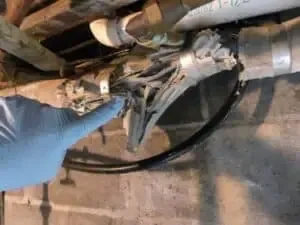I am demolishing or renovating a relatively new building. Do I still need an asbestos inspection?
Yes. A building being demolished or renovated must be inspected regardless of age. Asbestos-containing building materials are still made and available. Furthermore, the reuse of materials also increases the possibility that asbestos-containing materials may be in a newer building.
When do you need to inspect a building for asbestos?
All structures, regardless of the date of construction, must be inspected for the presence of asbestos prior to renovation or demolition.
When is a building material considered to be asbestos containing?
All building materials, except for rubber, glass, and metal are considered asbestos-containing until sampled per AHERA protocol and analyzed by a qualified lab. If the lab reports the amount of asbestos to be any amount greater than 1 percent, it is considered an Asbestos Containing Material (ACM). Materials above 1 percent are regulated by a state’s
Environmental Protection Agency (EPA) or other regulatory agency in the state (for example, in Pennsylvania asbestos is regulated through the Pennsylvania Department of Natural Resources).

Asbestos containing duct-tape
What do I need to do before renovating or demolishing a building?
Notify (For Demolition) – Most states require a Notification of Demolition to be sent with applicable fees 10 working days prior to the start of the demo project or asbestos abatement project (if required). The EPA or DNR requires this notification regardless of whether or not asbestos is present in the building.

Notify (For Renovation) – If the project involves the disturbance of 260 or more linear feet of asbestos pipe insulation or equal to or greater than 160 square feet of other Regulated Asbestos Containing Material (RACM), then the EPA or DNR requires a Notification of Demolition Form to be sent with applicable fees, 10 working days prior to the start of the project.
Abate (if asbestos is found) – Depending on the type of asbestos present and the demolition methods used, some or all of the asbestos-containing materials may have to be removed by a licensed abatement contractor prior to beginning demolition activities. Typically, asbestos-containing materials need to be removed if they are planned to be impacted during renovations. However, contractors can sometimes use workarounds to avoid abatement and impacting the asbestos-containing material during renovation (i.e. placing flooring over the top of asbestos-containing flooring, using chemical encapsulants to existing asbestos-containing materials, etc.).
Which building materials contain asbestos?
Over 3,000 different building materials are known to contain asbestos. Asbestos, a naturally occurring mineral, was used because it is heat resistant, an excellent insulator, a poor conductor, adds tensile strength, and is chemical resistant. Its uses include acoustical finishes, adhesives, fireproofing, flooring, thermal insulation, roofing materials, and wall systems.
Why is asbestos regulated?
Asbestos is a known human carcinogen and a cause of respiratory disease. There are no known safe levels of asbestos exposure.
Why do we need an asbestos survey prior to intentionally burning the building?
Most forms of asbestos burn at 2,732 degrees F (1,500 degrees C). Therefore, asbestos will not burn during a training burn. If asbestos
is not properly removed before the fire, some of it will contaminate the air and some of it will remain in the ash resulting from the fire. In a fire, most materials that contain asbestos would combust, rendering the asbestos fiber content friable and causing it to release into the air.

Asbestos-containing Air-o-Cell pipe insulation
When is floor tile regulated?
The definition of Regulated Asbestos Containing Material (RACM) includes Category I non-friable asbestos (including floor tile) that has become friable or has been subjected to sanding, grinding, cutting, or abrading.
This includes floor tile that is in poor condition and can be crumbled, pulverized, or reduced to powder using hand pressure and floor tile that has been removed using mechanical methods. However, the regulated status of the floor tile is not solely based on its condition prior to removal and method of removal but also depends on its condition as a result of removal. For example, if the methods used cause the floor tile to crumble or be pulverized or reduced to powder, then the floor tile is considered RACM.
What does friable mean?
Asbestos is divided into two categories: friable and non-friable. Friable means it crumbles when hand pressure is applied. Non-friable materials are further separated by whether or not they are resilient and pliable or rigid and brittle, and by whether they have the potential to become friable.
Where can asbestos be encountered in a building? Asbestos is found on and in boilers, heaters, piping, electrical equipment, flooring, ceiling tiles, plaster, drywall mud, and water heaters.
